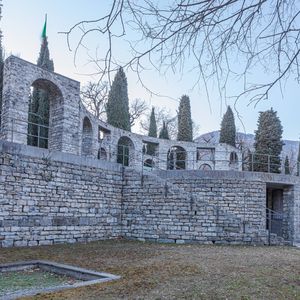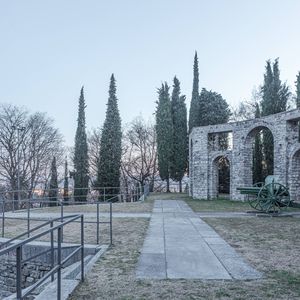Giuseppe Terragni, Monumento ai Caduti (War Memorial) of Erba Incino town, Erba (Como), 1926- 32
Compared to the vast production of Monumenti ai Caduti (War memorials), This work by Terragni does not yield to the rhetoric of direct celebration of events, nor does it resort to representation to "commemorate"; it takes place as a large-scale landscape intervention. Terragni practically creates a new access to the Licinium, a garden organised around an open-air theatre. The Monument consists of a large stone staircase oriented from west to east leading to the top of a hill and to a sacrarium. Its overall theme is therefore one of "ascent", of the ideal symbolic connection between high and low. The rectilinear development of the ramps is then made to interfere with another symbolism, that of the circle: the lower end of the staircase is circular, while the geometry of the building and the upper terrace is circular at the opposite end. The staircase, which overcomes a difference in height of about twenty-five metres, consists of four linear ramps interrupted by three landings and has a slope similar to that of the natural slope. Two rows of cypress trees accompany its development. The last ramp stops in front of a cylindrical volume that contains the crypt of the sacrarium inside and a terrace above it that leads to the view. The crypt, which is accessed through two portals, originally housed a beautiful high-relief bronze panel by Lucio Fontana, representing the Victory modelled in 1931, which after a few years was "offered to the motherland" as bronze and destroyed.

